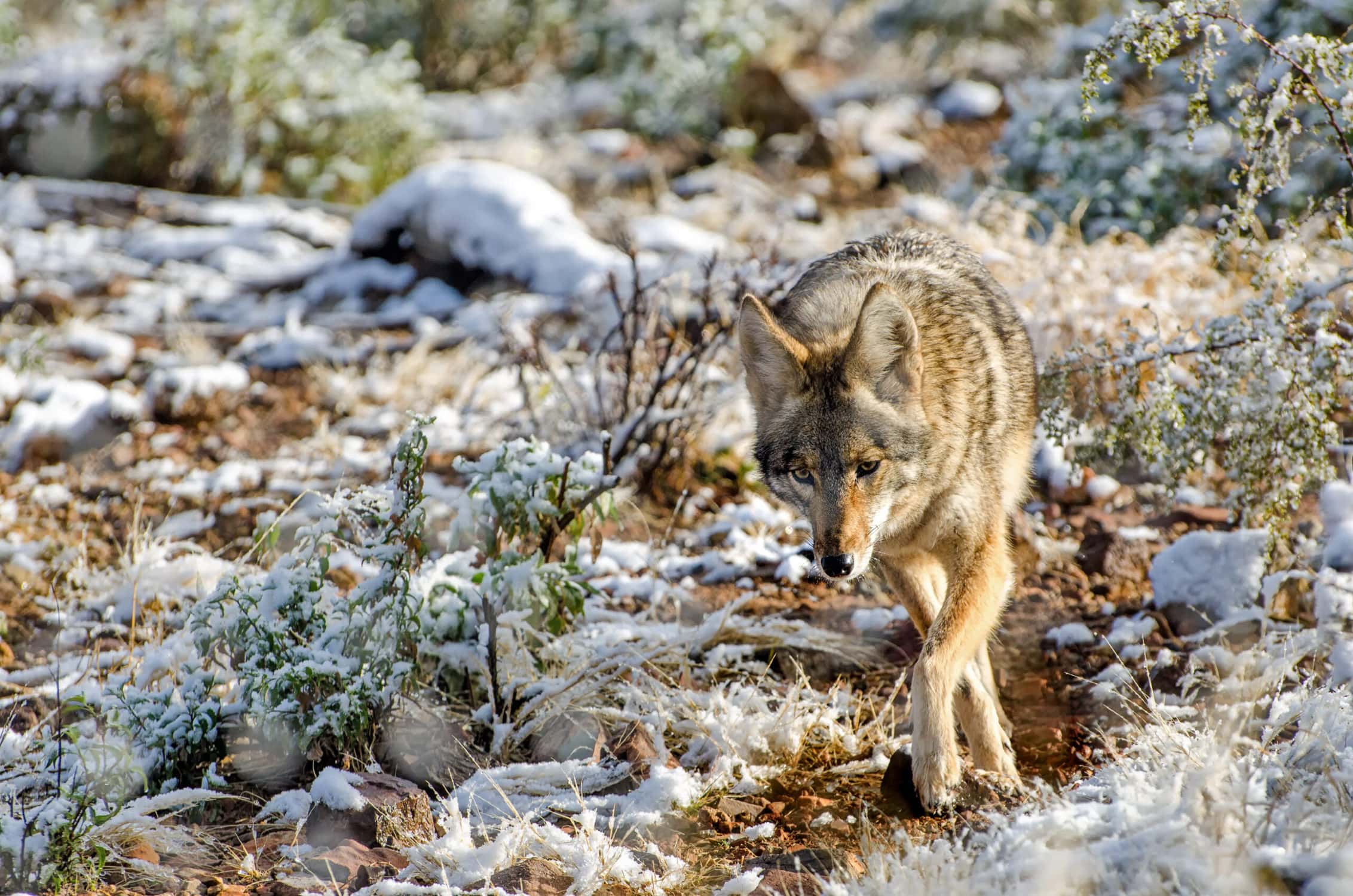
Whether you are just getting started hunting coyotes or you’ve been doing it for a while, there’s always more to learn.
Here, we will cover the basics on coyote hunting, how to hunt coyotes, and cover some of the best places to start your hunt.

If you want to jump ahead to a specific section, use our table of contents to get you there faster.
Coyote Basics
When hunting for coyotes, there’s a lot to know. So, let’s talk about some basics before we get into the hunting nitty-gritty.
Why Hunt Coyote?
Growing coyote populations and their natural adaptability mean that these animals are not only living but thriving. However, an abundance of coyotes in an area will reduce the population of other species, such as deer, livestock, and even domesticated animals. Increasingly, coyotes are becoming less fearful of prowling near neighborhoods and can be dangerous to local ecosystems if left unchecked.

That’s why most areas where coyotes are plentiful, are more than happy to allow hunting, in fact, many states welcome it and even host competitions. This is good news for hunters looking to bag some pelts.
So, first, you are helping keep the coyote population in check. Another great reason to hunt coyotes is the ability to hunt in the off season. Being able to target and perfect your hunting techniques can happen while hunting coyotes and make you all that much better when prime season returns.
If you hunt coyotes in the same area you plan to hunt whitetail, duck, or turkey, you will learn the land and be able to scout the area as well. This is a huge advantage come hunting season.
Where to Hunt Coyotes
While coyotes can be found nearly anywhere in the United States, there are some states with particularly good hunting opportunities due to generous hunting licensing, larger populations, or more public hunting land. Here are the top 7 states for coyote hunting
Pennsylvania
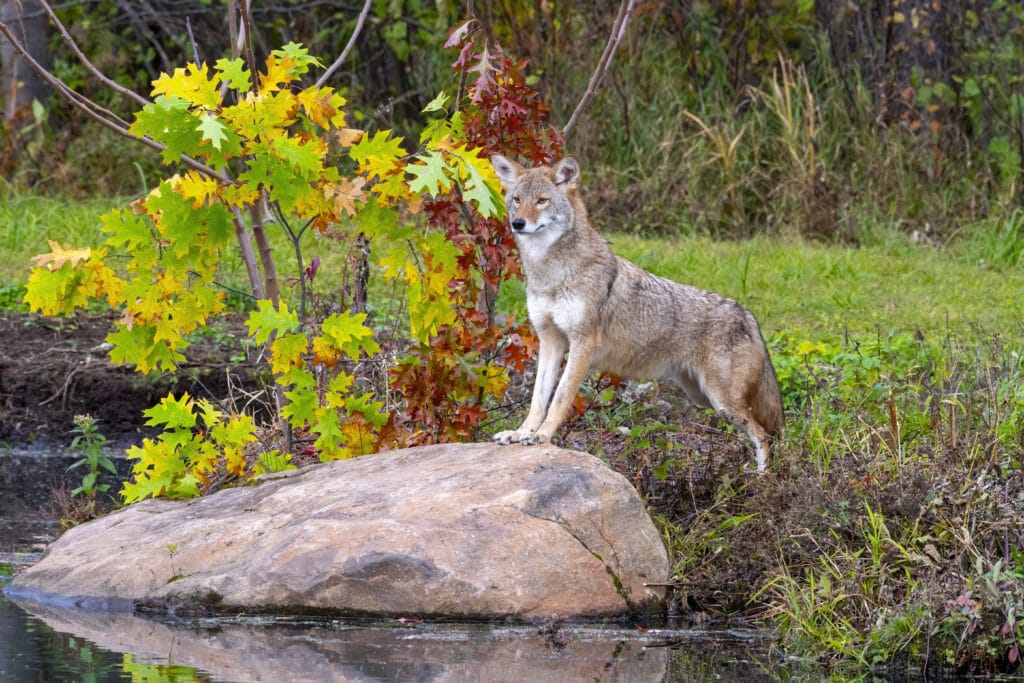
Pennsylvania allows year-round coyote hunting 24 hours a day and 7 days a week. You need a fur takers license or a license to hunt big game when in season, though. They also allow the use of electronic predator calls and the use of dogs to hunt.
Ohio
Coyotes can be hunted year-round in Ohio and although you need a license, very few other regulations exist due to coyotes being classified more toward city rat status. Night hunting and electronic calls are allowed, as are certain types of non-meat baits
Indiana
In Indiana, you need a hunting license but hunting on private land year-round is allowed on your land or with permission from the owner. There are no weapon restrictions and electronic calls, including recordings, are allowed. In fact, there are coyote hunting contests you can sign up for as well.
Colorado
Colorado also requires a furbearer’s license or small game license but night hunting is only available in certain places for specified times. You may use electronic calls and decoys to hunt coyotes.
New Mexico
Coyotes are classified as non-protected furbearers and non-game animals, and therefore, can be hunted freely, year-round without a license or bag limit.
Michigan
The state of Michigan allows coyotes to be hunted year round with just a base license. For trapping, you will need a furbearers license though. There are a few limitations of type of weapon and where it can be used, so check the regulations before heading out.
Nevada
Nevada allows hunting year round, no bag limits, no weapon limits, and no license is required unless you are trapping or selling the fur for profits. You may use dogs, bait, decoys, and electronic calls when hunting in NV.
As we said, many states have friendly laws for hunting coyotes. This is not an exhaustive list, but can get you off to a start and help you know what rules you should be aware of. Just do your research before you plan your hunt to be sure you are adhering to any rules and regulations for the state, city, county, or province you are hunting in.

Best Times For Hunting Coyote
Coyotes are nocturnal animals and are more active at night. This can present a challenge because it is difficult to see what you are hunting in the dark. However, there are hunting lights that will illuminate a coyote’s eyes with a color they cannot discern. Hunting near dawn or dusk will produce the best results when targeting coyotes.
As for time of year, coyotes can be hunted year-round in many places. If you are looking for pelts, your best bet is hunting in winter when their coats are thick. Fall can be a great time to hunt, as young coyotes are weaned and may not yet be hunter-savvy.
Coyote Hunting 101
It may seem like a no-brainer to go out and shoot a coyote. However, there is a specific technique to it and many ways to be properly prepared.
If you’ve never hunted coyotes before, the information below will help you out. Anything worth doing is worth doing well, so be sure you are armed with the information you need before you plan your hunt.
How to Hunt Coyote
When hunting coyotes, being unseen is key. From the moment you pull up in your truck, until the moment you drive away with your kills, you must be aware of how much attention you are attracting.
Be Invisible
Coyotes have excellent hearing and once you’ve been revealed, it is difficult to become invisible.
By the same token, camo is mandatory. If you stick out like a sore thumb, a coyote won’t get within range. Not only do they have excellent hearing, but their eyesight is sharp too.
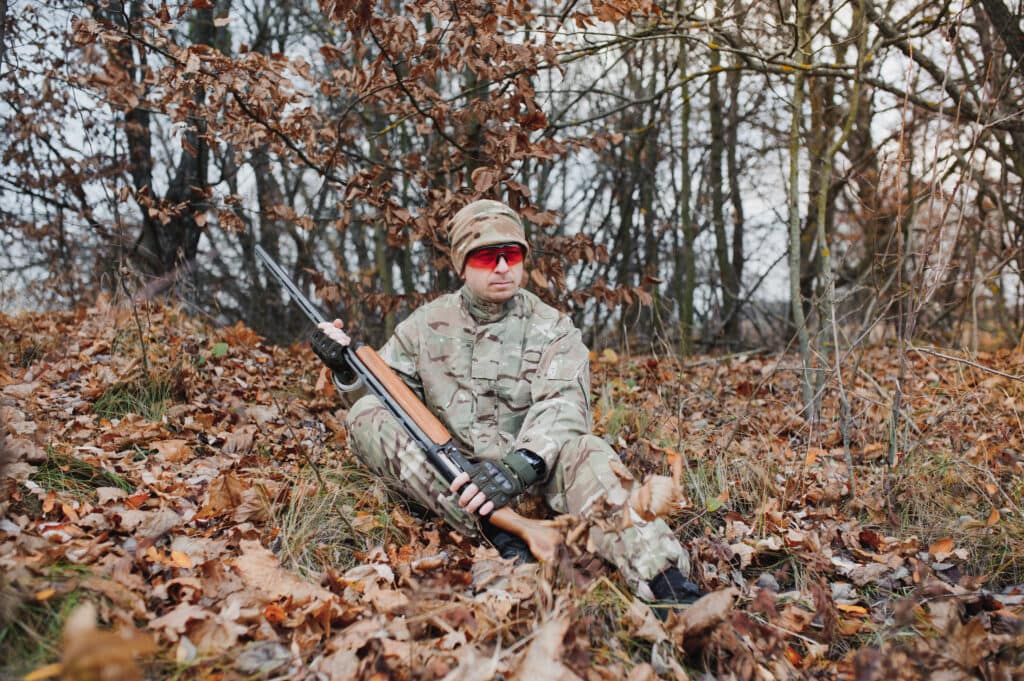
Set Up Your Shot
Plan your spot well and set up your location. You should be positioned for a shot without moving much. Once a target approaches, any movement will put it on guard, so choose your position carefully.
Call Them To You
Use a unique call. If you and every other hunter are using the same call, a coyote will catch on pretty quickly. Once you start calling, give it 30 minutes to an hour before switching tactics. Be sure you know what call you are using and how it works.
Be Patient
Don’t expect to bag a kill every 15 minutes or even every hour. Sitting quietly is difficult but is the best way to draw in your prey. If after an hour, there’s been no activity, try moving to a different location or waiting until dark.
Coyotes can be very smart and have enhanced senses. Even if you don’t see or hear them, they can easily find, and avoid, you. So choose every aspect of our hunt carefully.
Coyote Hunting Gear
If you don’t have the right coyote hunting gear, you are sure to struggle during the hunt. Using the wrong call type, an over or underpowered weapon, or choosing the wrong camo can set you up for failure. Here is some essential gear when hunting for coyotes.

Rifle or Bow
You will need a sufficient rifle or shotgun with the ability for follow-up shots, paired with the right ammo. Common ammo types for coyotes are .223 Remington, .204 Ruger, and .243 Winchester, to name a few. Choose whatever fits your shooting style best. You want to be sure your ammo expands quickly upon impact for a quick, ethical kill.
While bowhunting for coyote adds another layer of challenge, it can be done. Choosing the right combination of bow and broadheads can achieve the same results as using a rifle when done correctly.
Hunting Lights
As mentioned earlier, hunting lights allow you to hunt at night without your light being detected. These lights use colors coyotes cannot see. However, these lights illuminate the animal’s eyes so you have a clear idea of where your prey is located. This is a vital tool, particularly when hunting in the dark.
Shooting Rest
Having somewhere to rest your rifle while waiting will minimize the amount of movement it takes to get into position when a coyote responds to your call.
Call
Speaking of calls, you want to get a good quality coyote call. Try to choose one that is different from what every other hunter has. Choosing a prey distress call is often more effective than choosing a coyote call. Whether you choose a mouth call, electronic call, or a recording, be sure you use one that is recognizable in your area.
Also, choose your call in relation to the season. During mating season, coyote vocalizations, especially the female type, are effective. In the early season when pups are everywhere, a pup call will surely hit the mark. In non-mating seasons, a prey call is likely the best choice.
Decoy
Having a decoy that thrashes around, covered in some type of fur can assure a coyote that some injured prey is nearby when a call draws them in. These are relatively easy to cart around.

Camo
Again, being discreet is the name of the game. Try to make yourself as unseen as possible by wearing camo that blends in with your surroundings. Also be sure to break up your outline by standing near natural landmarks like trees, rocks, or hills.
Seat
This seems like more convenience than necessity but when sitting on the ground with no support, trying not to move, your bones and joints can ache and your hands and feet may get pins and needles. If your body is not in prime ready-condition, moving into position can alert your prey. With an adequate seat, you can be sure you are reasonably comfy and ready for that shot.
There are many other supplies that can help you when hunting coyotes such as a hunting pack, optics, rangefinders, traps, and headlamps. The more you hunt, the better you’ll come to know what you, personally, need for success.
Coyote Hunting Tips And Mistakes
There are many things to learn and consider before hunting. Here are some coyote hunting tips.
Coyote Hunting Tips
● Scout the Area – do this in the evening or at night. Listen for where they are and look for potential setup areas with sufficient cover.
● Watch the Wind– Be sure the wind isn’t revealing you by keeping the wind at your face or perpendicular away from your target area.
● Shut Off the Call- When your target comes into view, turn the call off so he has to search. This slows the hunt and gives you the opportunity for multiple shots.
● Wear Your Invisibility Cloak- Make yourself as invisible as possible, in every way. Be aware of the sounds, smells, and visuals you are giving off.
● Mix Up the Calls- having a hand call and an electronic call can be the mix you need to entice the coyote into range.
How To Use A Coyote Call
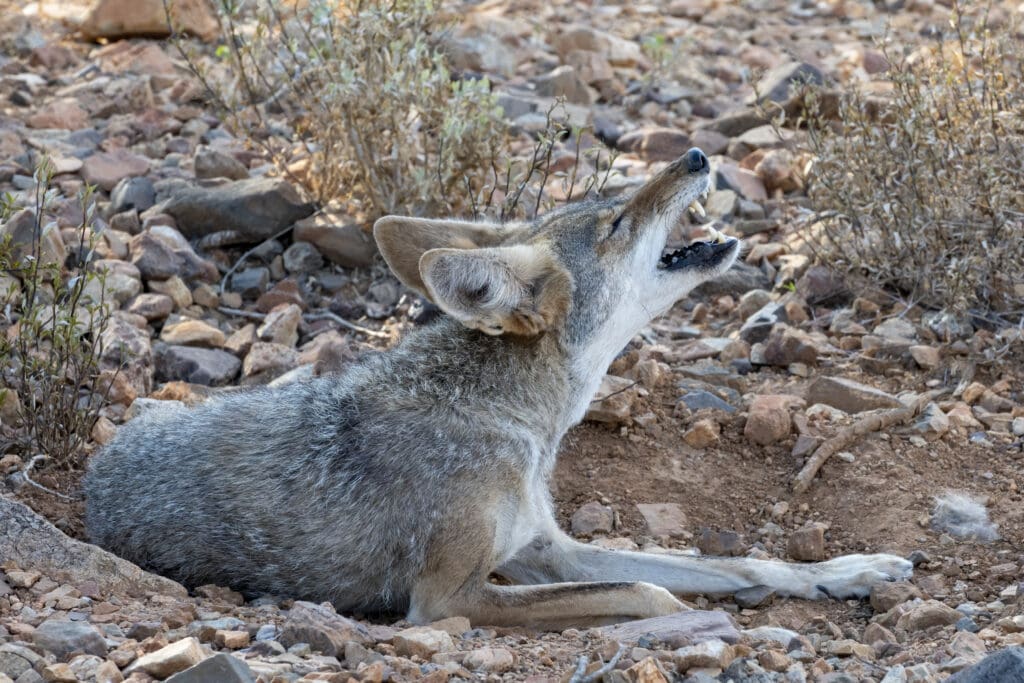
Using an Electronic Call
Know how the call works and start softly. Gradually increase the volume, keeping your eyes focused on the target area. As soon as a coyote gets within range, line up and take your shot.
If your target loses interest, try switching to a hand call to lure it the rest of the way.
Each call works differently, so you will need to practice with your call and know the features and how it works to utilize it effectively. Read the manual to learn about the features.
How To Use A Coyote Decoy
Once you’ve called the coyote into the area, your decoy can help draw it in so you can solidify your shot.
Make sure your decoy pairs with your call. If you are using a prey sound, your decoy needs to look like prey. A bit of fur moving erratically will assure a coyote that what he hears and sees match.
If you are using a mating call, you’ll want to have male and female decoys set up to match.
When setting up, be sure you place the decoy at least 50-75 yards away from you.
Your main goal is to get the coyote’s attention and use the decoy to further draw it in so you can make the shot.
Where To Shoot A Coyote

For the quick, ethical shot hunters strive for, you should aim to hit a coyote right behind the shoulder. This is because the heart is directly behind the shoulder, unlike in larger game animals.
If you hit behind the shoulder, you are still likely to get a kill but this shot may take a bit longer, as it’s likely to hit the liver instead of the heart. In a coyote, the heart and lungs sit farther forward than in other animals, so ethical shot placement is slightly different.
Coyote Hunting Mistakes
Not all hunting follows the same rules. Many newbies are prone to common coyote hunting mistakes. Here are a few:
Hunting Where There Are No Coyotes
New hunters assume that every location will yield a plentiful harvest but it is important to know if coyotes frequent the area and how often. Make sure to scout your area before the hunt.
Using the Wrong Call or Not Calling Correctly

There is a science behind how loudly, often, and long to call a coyote. You also have to choose a call relevant to the target. If it’s mating season, the sound of pups in distress will fall on deaf ears since they have not been born yet. Using a prey sound that isn’t common to the area can also leave you empty-handed.
Leaving Yourself Poor Visibility
Coyotes are stealthy and won’t prance in. They will slink into the area, using cover to find the source of the call. Be sure your position is optimized to notice slight movements and hidden prey creeping toward you.
You Announce Yourself
From the rumble of your engine to the crunch beneath your boots, you set yourself up for failure if you aren’t as silent as possible from the very moment you arrive. Once a coyote spots you, they will avoid the area at all costs.
Giving Up Too Early
Coyote hunting, like most hunting, is an exercise in patience. Most animals have been tricked before and are wary of their surroundings. Take your time and be patient with the process. Don’t move positions or head home right before your work pays off.
You’re Hunting the Wrong Spot
This can be because the place you’ve set up is too widely used and animals in the area are wise to it. Or because there isn’t enough space around you to draw coyotes in. You want to have a clear view of the area, which may mean elevating yourself on a hill so you can see the low points.
These common mistakes are all part of the learning process. Don’t beat yourself up if you make a mistake. Chalk it up to experience and you’ll know better for the next one.
Conclusion
Coyote hunting is fun, challenging, and actually beneficial for the ecosystem. Hopefully, this article has given you the information you came here for and has prepared you for your next hunt.
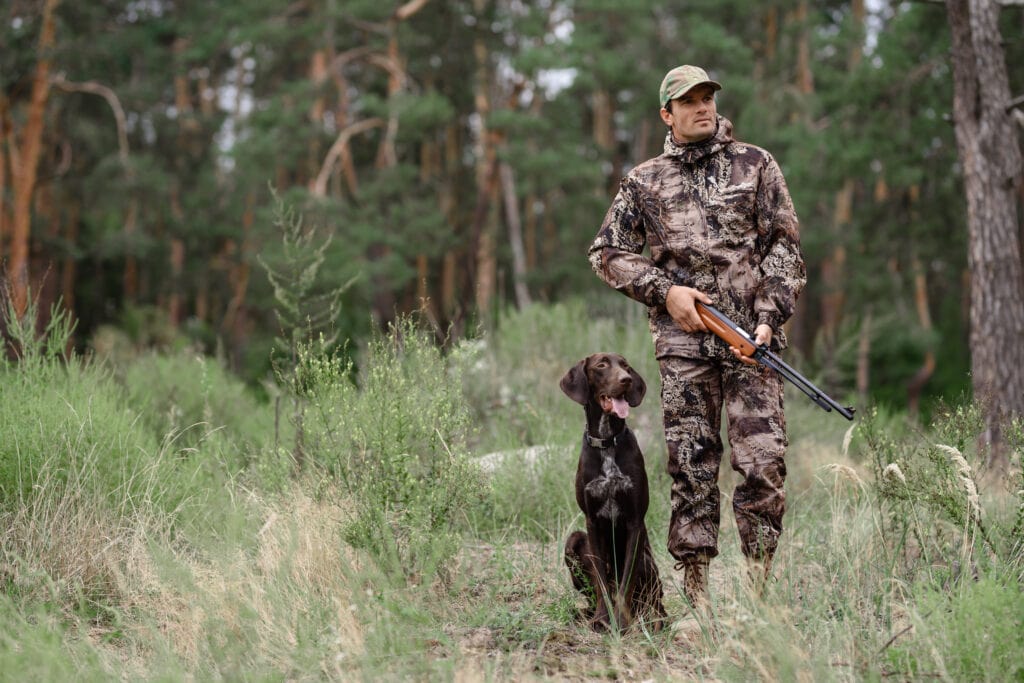
Be sure to check out the linked pages within the article to read more about the tools and techniques to use when hunting coyotes. Whatever type of hunter you aim to be, it takes practice, the right equipment, and a bit of research to get you in the game. Since this can be done year-round, if you have an unsuccessful hunt, just wait a few weeks and head out again. Happy hunting.

Big Game Logic is a participant in the Amazon Services LLC Associates Program, an affiliate advertising program designed to provide a means for us to earn fees by linking to Amazon.com and affiliated sites. Pages on this site may include affiliate links to Amazon and its affiliate sites on which the owner of this website will make a referral commission
